Is your eCommerce store struggling to attract organic traffic despite having amazing products? Are you lacking visits from potential customers because your product pages aren’t optimized? Would you like to know the keyword search volumes for your products? Your competitors might be outranking you simply because they’ve mastered SEO for eCommerce product pages.
Recent studies show that 39% of all eCommerce traffic comes from search engines, yet many online stores neglect the fundamental optimization strategies that could dramatically improve their visibility.
Don’t be one of them.
The battle for visibility in search engine results has never been more competitive for online retailers. With over 24 million eCommerce sites operating globally, standing out requires more than just great products—it demands strategic optimization that speaks directly to both customers and search algorithms.

Investing in search engine optimization for your product pages delivers long-term ROI that paid advertising simply cannot match. While PPC campaigns stop generating traffic the moment you stop paying, properly optimized web pages continue working for you 24/7, bringing qualified prospects directly to your offering.
The difference between mediocre and exceptional product page optimization often determines whether potential customers find your store or your competitors’.
Implementing the professional recommendations in this guide will improve your search engine rankings and enhance the shopping experience, potentially increasing traffic and conversion rates for your eCommerce businesses.
Essential Elements of Optimized Product Pages
Strategic URL Structure
Product page URLs should be short, descriptive, and contain primary target keywords. A clean URL structure like yourstore.com/category/product-name signals relevance to both users and online search platforms.
Each character in your product URL should serve a purpose, ideally reinforcing the product name and primary category to help search engines understand the page’s content and display properly in search results.
Optimized Title Tags
When it comes to eCommerce product pages, the optimizing title tags (H1) is often the most critical on-page element for search engines. The key is to include your primary keyword early on – ideally within the first 50-60 characters – to maximize its SEO impact.
But here’s the thing: crafting a compelling title is about more than just throwing in a keyword. It’s about striking the perfect balance between optimization and click-worthiness. A well-crafted title should signal to search engines that your page is relevant, while also enticing users to click through from search results.
Compelling Meta Descriptions and Meta Tags
While meta descriptions aren’t direct ranking factors, they significantly impact click-through rates from search engine results. Include your primary relevant keywords naturally within a compelling 150-160 character description that addresses the customer’s needs.
Always write unique meta descriptions for each product page rather than allowing search engines to generate them automatically. This level of customization signals quality content to both search engines and potential customers browsing your online store and can significantly improve click-through rates from search results.
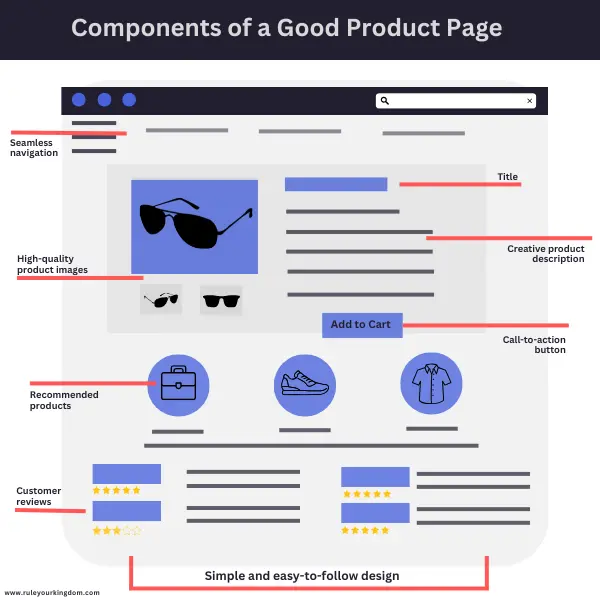
Image Optimization
Product images aren’t just for customers – they’re also a vital eCommerce SEO asset when optimized correctly. Unlock the full potential of your eCommerce site’s product pages when you do the following:
- Using descriptive, keyword-rich file names for your product images.
- Add alt text that accurately describes the image content and includes your primary keyword naturally. This helps search engines recognize the image and provides accessibility for visually impaired users.
- Compress high-quality images to maintain fast loading speeds without sacrificing visual appeal.
- Consider adding image structured data to help your product images appear in Google Images and visual search results, providing another traffic source for your eCommerce store.
Comprehensive Product Descriptions
Product descriptions should be unique, compelling, and at least 300 words long to provide sufficient context for search engines. Avoid manufacturer-provided descriptions that create identical content across multiple websites.
Incorporate primary and secondary keywords naturally throughout the description while highlighting the key features and benefits of the product. The best product page descriptions serve both SEO and conversion goals simultaneously.
Schema Markup Implementation
Structured data markup using schema markup is a must-have for SEO for eCommerce product pages. By implementing product schema, key product info like pricing, availability, and reviews are easily recognized by search platforms. This eCommerce SEO strategy can lead to enhanced listings with rich snippets, boosting click-through rates for your content marketing efforts.
To get it right, use tools like Google’s Structured Data Testing Tool or Schema.org‘s validators to ensure error-free markup. Layer multiple schema types, such as Product, Offer, and Review for a comprehensive approach. Consider adding rich snippets, How-To, and FAQ schema to capture more SERP real estate and drive more traffic to your online store.
Advanced On-Page SEO Tactics for eCommerce Brands
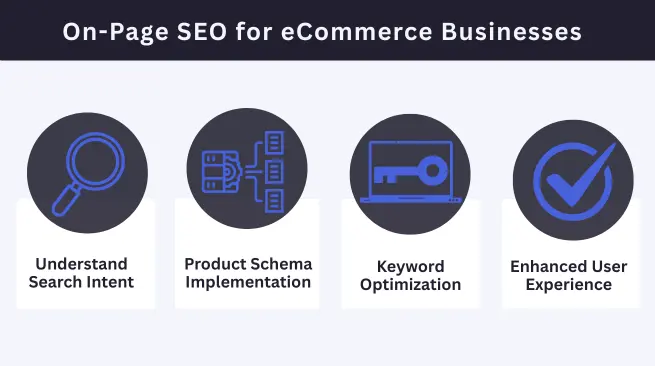
Understanding Search Intent
Understanding search intent is key to SEO for eCommerce product pages. Every keyword has a specific purpose, whether someone is looking for information, searching for a particular product or brand, or ready to buy. Your content should match that intent.
For eCommerce stores, this means using broader keywords on category pages and high-conversion keywords on product pages. This way, you’re meeting customers where they are in their buying journey.
Use Google Search Console’s keyword research data to identify which pages already rank for specific intent-specific terms and optimize them further. This approach refines your SEO strategy by leveraging existing momentum rather than starting from scratch.
Enhanced Product Schema Implementation
Basic structured data implementation is just the beginning. To take your eCommerce SEO to the next level, leverage advanced product schema properties like brand, aggregate rating, offers, and review markup. This can help you land those coveted rich snippets that stand out in search results.
Take a closer look at your competitors’ rich snippets – are they showcasing features you’re not? Tools like Schema App or SEMrush’s Site Audit can help you identify gaps in your structured data implementation compared to top-ranking competitors.
Another smart move is to implement FAQ schema on product pages. By answering common customer questions directly in search results, you can capture more SERP real estate and boost your visibility. It’s a win-win: customers get quick answers, and you get more prominence in search.
Semantic Keyword Optimization
Search algorithms are getting smarter by the day. They can spot relationships between terms, making it less about stuffing your product descriptions with exact keywords and more about providing a comprehensive picture of your products and offerings.
Include semantically related terms throughout your product descriptions to signal to search platforms that you’re an authority on your topic. Think of it like having a conversation with a customer—you wouldn’t just list features but also explain how they fit into the bigger picture.
Use tools like MarketMuse or Clearscope to identify your target keywords, then incorporate them into your content so search engines know the full context of your offering. However, don’t just rely on tools. Look closely at customer reviews for natural language patterns that can inform your keyword research strategy.
The terms customers use to describe your products often represent valuable semantic keywords that can help you create more authentic and compelling product descriptions.
User Experience Signals for eCommerce SEO
Search engines increasingly factor user experience metrics into ranking decisions, making page experience optimization critical for eCommerce websites.
Building an eCommerce store website with high-quality images, intuitive navigation, clear and concise product information, a straightforward checkout process, and a focus on mobile optimization and accessibility can improve SEO performance and conversion rate optimization.
Implement click tracking to identify navigation patterns and optimize your site structure accordingly. Understanding how users navigate your store provides invaluable insights for optimizing in-page link strategy and menu structure.
In-Depth Keyword Research Strategy for eCommerce
Creating a Comprehensive Keyword Matrix
Effective keyword research starts with categorizing terms by search intent, volume, and competition. Segment keywords into high-intent, high-volume, and long-tail keywords and transactional, navigational, and informational categories to match your sales funnel stages.
Tools like Google Keyword Planner, Ahrefs, and SEMrush help identify relevant keywords with meaningful search volume.
Additionally, a competitive keyword research analysis will reveal your top-ranking competitors and what keywords they use to drive their natural traffic. Focus particular attention on terms where competitors rank in positions 1-3, as these likely represent their most effective keyword research targeting data.
Examine competing pages’ product page SEO elements (titles, descriptions, content) to understand how they optimize for their target terms. This will provide valuable insight into keyword research, placement, and content structure ideas.
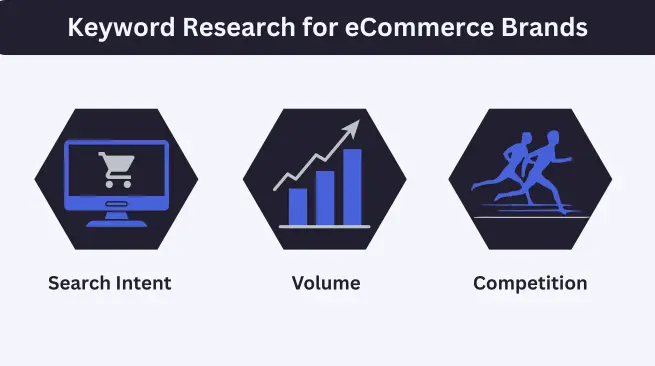
Leveraging Amazon for Keyword Discovery
Amazon’s search bar provides invaluable insights into high-intent search queries used by active shoppers. The autosuggest function reveals exactly what customers are searching for when they’re ready to make purchase.
Compare Amazon-derived keywords with Google Keyword Planner and Google Analytics data to identify gaps in your current targeting strategy. This cross-platform approach ensures you capture keywords from both general and marketplace-specific search behaviors.
Prioritizing Buyer Intent Keywords
Keywords with clear purchase intent should prioritize product pages and title tags over informational terms. Phrases containing modifiers like “buy,” “best,” “top,” “review,” or specific model numbers typically indicate higher purchase intent.
Analyze the conversion rates of different keyword types in Google Analytics to identify which terms bring the most valuable traffic. Terms that drive traffic but few conversions might be better targeted through blog content rather than product pages.
Create a tier system for your keywords based on a combination of search volume, competition, and intent. This structured approach ensures you’re allocating your optimization efforts to terms likely to drive revenue, not just traffic.
Content Marketing Strategies to Support Product Pages
Creating a Content Ecosystem
Develop comprehensive blog post content that addresses common questions, comparisons, and use cases related to your products. This content marketing serves as both an SEO asset and a pre-sales education tool for customers who aren’t yet ready to purchase.
Implement a hub-and-spoke content model where detailed product pages are supported by related article content addressing broader topics. This structure creates natural opportunities for relevant internal links that pass authority to your product pages when creating pages for your catalog.
Schedule content creation to target seasonal trends and shopping periods relevant to your products. Planning content 3-6 months ahead of peak shopping seasons gives search engines sufficient time to index and rank your relevant pages before demand peaks.
Optimizing Product Descriptions for SEO and Conversions
Craft product descriptions that satisfy both SEO and conversion optimization. Incorporate targeted keywords naturally while addressing customer pain points and highlighting unique selling points.
Use scannable headings with secondary keywords to boost readability and SEO signals. Include detailed technical specs and structured information to answer customer questions and capture long-tail keywords.
Meta Descriptions as Marketing Tools
Create compelling meta descriptions that function as mini-advertisements in search results. Include unique selling points, promotions, or guarantees that differentiate your products from competitors to maximize click-through rates.
Test different approaches to meta descriptions across your catalog and measure their impact on click-through rates via Google Search Console. Additionally, dynamic meta description templates can be updated with current pricing, availability, and promotional information.
Strategic Internal Linking
Every relevant mention of a product on your eCommerce business site – whether it’s on category pages, blog posts, or other relevant content – should link to the corresponding product page using keyword-rich anchor text to strengthen your on page SEO.
Create resource pages that logically group relevant pages and educational content together. These topical hubs help provide search engines with clear signals about the relationship between different pages on your site and establish topical authority.
Regularly audit existing content to identify new relevant internal link opportunities as your product catalog expands. Many eCommerce websites miss valuable linking opportunities between other relevant pages simply because they fail to update older content as new products are added.
Develop a hierarchical internal linking structure prioritizing your most important category and product pages. This purposeful approach to internal links ensures that your most valuable pages receive the most internal link equity to support their rankings.
Implement breadcrumb navigation, which creates additional contextual internal links throughout your eCommerce business store. Breadcrumbs improve user navigation and establish clear topical relationships between your pages, helping search engines learn about your site structure.
Leveraging User-Generated Content
Implement a strategy to encourage user-generated content, such as FAQs, reviews, blog posts, and usage examples. This content adds unique, keyword-rich material to your pages while addressing potential buyers’ concerns.
Develop systems to moderate and highlight the most valuable user contributions. The best customer reviews naturally incorporate relevant keywords and specific product benefits, supporting your SEO efforts.
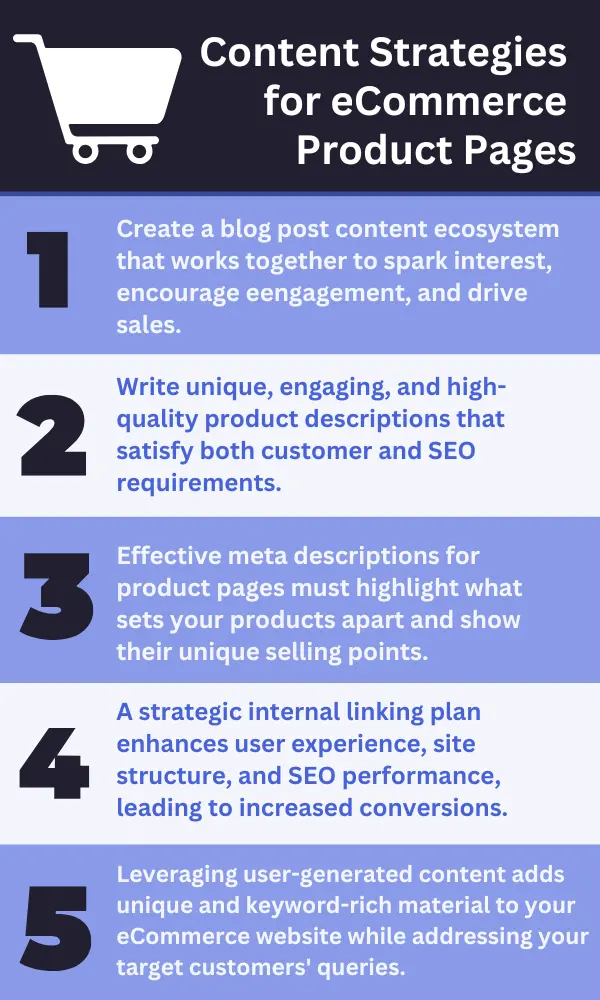
Technical SEO Essentials for eCommerce Sites
Optimizing Site Architecture
Design your site structure so product pages are no more than three clicks from the homepage. This simple and straightforward architecture ensures that search engines understand and can easily index your product pages.
Additionally, using breadcrumb navigation reinforces your site structure and improves usability. Properly marked-up breadcrumbs with structured data help search engines recognize your site hierarchy while improving user navigation.
Page and Site Speed Optimization
On-page optimization includes regularly testing your eCommerce shop’s site speed. You can use tools like Google PageSpeed Insights and implement their recommended improvements. Page speed is a direct ranking factor that also significantly impacts conversion rates, with studies showing that each second of delay decreases conversions by up to 7%.
Leverage browser caching for static assets like images, CSS, and JavaScript files to reduce HTTP requests and improve page and site speed loading times on repeat visits.
Mobile Responsiveness
Another vital on-page optimization strategy is to ensure that your product pages have a mobile-responsive design that adapts to all devices.
With mobile-first indexing, your online store’s mobile performance impacts online rankings. Test the entire purchase journey on multiple devices, focusing on touch-friendly navigation, readable text, and sized buttons to optimize both SEO and conversion rates.
Preventing Duplicate Content Issues
When products appear in multiple categories or have filter options that generate unique URLs, canonical tags manage product variations and indicate which version should be indexed.
Use 301 redirects for permanently discontinued products rather than letting the pages return 404 errors. This practice preserves any link equity the product pages have accumulated and transfers it to relevant alternative products.
Develop a strategy for handling manufacturer product descriptions that might appear on multiple sites. Enhancing these descriptions with unique content specific to your store helps avoid duplicate content penalties affecting rankings.
XML Sitemaps and Breadcrumb Implementation
Create and regularly update XML sitemaps for product pages, especially for extensive catalogs. Separate sitemaps for different product categories can help search engines crawl and index your content more efficiently.
Submit your sitemaps via the Search Console and monitor crawling statistics for insights into how search engines process your pages. Addressing crawl errors promptly ensures all your product pages are properly indexed.
Implement structured breadcrumbs that reinforce your site hierarchy and help users navigate between categories. When properly marked up with schema, breadcrumbs can appear in search results and improve click-through rates.
Security Implementation
Ensure your entire eCommerce site uses HTTPS encryption to protect customer data and gain the associated ranking benefits. Google has confirmed HTTPS as a ranking factor, and Chrome now visibly marks non-HTTPS sites as “Not Secure,” potentially reducing visitor trust.
Implement proper security headers, including Content-Security-Policy and X-XSS-Protection. These technical measures protect your site from common attacks while signaling to Google that your site prioritizes security.
Regularly scan for security vulnerabilities that could compromise your site or customer data. Security breaches can result in search penalties if they lead to compromised content or malware distribution through your site.
Proven Link-Building Strategies for eCommerce
Resource Page Link Building
Identify industry resource pages that list products or services in your niche. These curated collections often link to the best product pages and category pages in specific industries.
Create a personalized outreach campaign highlighting why your products deserve inclusion on these resource pages. Focus on the unique features, quality, or value your products offer compared to others already listed.
Track your success rate and refine your approach based on feedback. Resource page link building typically delivers higher success rates than many other outreach methods when approached with genuine value propositions.
Influencer and Blogger Partnerships
Develop relationships with influencers and bloggers who create content relevant to your products. These partnerships can generate high-quality backlinks from content that genuinely recommends your products.
Consider providing products for honest reviews rather than simply asking for links. Authentic reviews from trusted sources generate quality backlinks and build credibility with potential customers.
Track the performance of influencer-driven traffic through dedicated landing pages or UTM parameters. This data helps identify which partnerships deliver the most valuable traffic and conversions, allowing you to focus on scaling successful relationships.
Broken Link Building
Use tools like Ahrefs to identify broken links on industry websites that once pointed to products similar to yours. This technique finds link opportunities where webmasters are likely receptive to replacement suggestions.
Create a compelling outreach email that notifies the website owner of the dead link and suggests your product page as a relevant replacement. This approach positions your outreach as helpful rather than self-serving.
Scale this strategy by creating a system to regularly check for new dead link opportunities as competitors discontinue products or change their site structure. Timely outreach when broken links first appear typically yields higher success rates.
Competitor Backlink Analysis
Conduct a thorough analysis of competitors’ backlink profiles using tools like Ahrefs or Majestic. Focus on identifying which types of content and which specific pages attract the most valuable links.
Segment competitor backlinks by acquisition strategy (guest posts, product reviews, resource mentions) to understand which approaches work best in your industry. This analysis reveals the most efficient link building tactics for your niche.
Prioritize outreach to sites that link to multiple competitors but not to you. These sites have already demonstrated a willingness to link to businesses in your niche and represent the lowest-hanging fruit for your link building efforts.
Strategic Guest Posting
Identify relevant websites that publish content related to your products and accept guest contributions. Focus on sites that reach your target audience rather than pursuing guest post opportunities based solely on domain metrics.
Create genuinely valuable content that subtly incorporates mentions of your products where relevant. The most effective guest posts provide standalone value while naturally creating opportunities to reference your products.
Develop relationships with publications for ongoing contribution opportunities rather than one-off posts. Established contributor relationships typically lead to more natural link placements and greater overall link acquisition efficiency.
Measuring eCommerce SEO Success
Setting Up Proper Tracking
Configure Google Analytics and Search Console to track organic website traffic, specifically on product pages. Set up segments to isolate and analyze organic product page traffic separately from other traffic sources and page types.
Implement enhanced eCommerce tracking to connect online traffic to revenue metrics. This configuration allows you to identify which optimized product pages deliver the highest return on investment for your eCommerce store.
Create custom dashboards focusing on key performance indicators specific to product page performance. These dashboards should track metrics like organic entrances, bounce rate, and conversion rate at the individual product level.
Key Performance Metrics to Monitor
Track keyword ranking improvements across your target keyword portfolio. Focus particularly on movement for high-intent transactional terms that directly relate to your products and monitor their position changes over time.
Monitor traffic growth at both the site level and individual product page level. Segment this analysis by new versus returning visitors to understand how your eCommerce SEO efforts are expanding your customer base.
Analyze user behavior metrics, including bounce rate, pages per session, and average session duration for organic traffic. Improvements in these metrics often precede ranking improvements as search engines recognize better user engagement on your web pages.
Advanced Analytics Configurations
Set up regular content audits using a combination of Google Search Console data and crawling tools. These audits should identify underperforming content, cannibalization issues between category pages and product pages, and opportunities for content consolidation.
Implement funnel visualization for online traffic to identify potential sticking points in the conversion path. This analysis helps pinpoint where optimizations beyond basic product page SEO might be needed to improve overall conversion rates.
Create custom channel groupings that separate brand and non-brand organic traffic to understand your optimization efforts’ impact better. This segmentation provides clearer insights into which improvements are driving new customer acquisition versus serving existing customers.
ROI Calculation for SEO Efforts
Establish a transparent methodology for attributing revenue to SEO efforts that account for assisted conversions and proper attribution windows. This approach provides a more accurate picture of SEO’s contribution to your bottom line.
Compare traffic acquisition costs to paid traffic on a cost-per-acquisition basis. This analysis typically demonstrates the long-term value proposition of investing in eCommerce SEO compared to continuous paid advertising.
Develop forecasting models that project future online traffic growth based on historical trends and planned optimization efforts. These models help justify ongoing SEO investments by illustrating the compounding returns of consistent optimization work.
Continuous Improvement Process
Establish a regular cadence for SEO performance reviews and optimization cycles. Most eCommerce sites benefit from monthly technical audits and quarterly content refreshes for key product pages.
Implement a systematic process for applying learnings from high-performing pages to underperforming ones. This pattern-recognition approach helps scale successful optimization techniques across your entire product catalog.
Develop a testing framework for evaluating title tags, descriptions, and content structure changes. A/B testing these elements can reveal which approaches drive the best combination of rankings, click-through rates, and conversions.
Common eCommerce SEO Pitfalls and How to Avoid Them
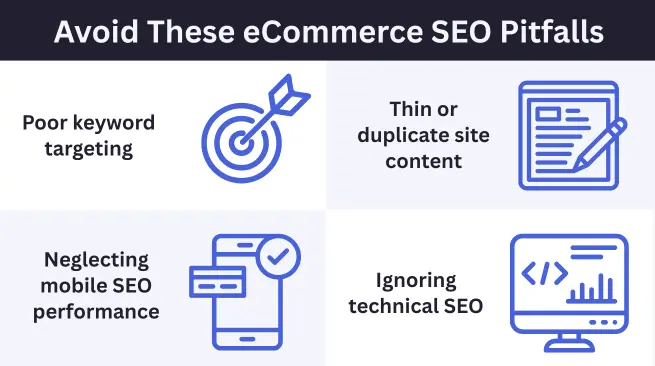
Poor Keyword Targeting
Many eCommerce sites target broad category terms on product pages instead of specific product-focused keywords. Align your keyword targeting with the specificity of the page—broad terms for category pages and specific terms for product pages.
Avoid keyword stuffing in an attempt to rank for multiple terms. Modern SEO rewards natural language and topical relevance over keyword density, so focus on comprehensive coverage rather than repetition.
Review search queries in Google Search Console regularly to identify misalignments between your targeting and actual search behavior. These insights often reveal opportunities to align your optimization with real user searches better.
Overlooking Mobile Experience
Don’t assume that a technically responsive site delivers a good mobile user experience. Mobile usability involves more than just scaling—it requires rethinking navigation, product filters, and checkout processes for touch interfaces.
Avoid using mobile interstitials that obscure content, as these can trigger Google penalties. If you need popups for email capture or promotions, ensure they follow Google’s guidelines for acceptable mobile interstitials.
Test how your site looks on mobile and how it performs with realistic mobile conditions. Use Chrome DevTools to simulate slower 3G connections and test your site’s usability under these constraints.
Thin or Duplicate Content
Avoid using manufacturer descriptions verbatim across your product pages. These syndicated descriptions create duplicate content issues that can prevent your pages from ranking effectively.
Don’t create separate pages for minor product variations unless they target distinctly different keywords. Instead, use product options and variant selectors to avoid creating thin content pages for simple color or size variations.
Regularly audit your site for automatically generated pages that might duplicate content. Filter pages, sorting options, and pagination can sometimes create indexable duplicate versions of your product pages if not properly managed.
Technical SEO Negligence
Don’t launch new products or categories without checking for technical SEO essentials. Create a pre-launch SEO checklist covering canonical tags, schema markup, and mobile responsiveness.
Avoid making major platform or design changes without an SEO migration plan. Many eCommerce sites lose significant rankings after redesigns or platform migrations due to changed URLs, content structure, or technical implementations.
Don’t neglect regular technical SEO audits to focus solely on content. Technical issues like crawl errors, redirect chains, or rendering problems can undermine even the best content optimization efforts.
Taking Your eCommerce Product Page Optimization to the Next Level
The most successful eCommerce businesses recognize that SEO for product pages isn’t a one-time project but an ongoing process of refinement. Implementing the strategies outlined in this guide will put you ahead of most competitors, but the work doesn’t stop there.
Search algorithms continue to evolve, consumer behavior shifts, and competitive landscapes change. The eCommerce websites that maintain strong organic visibility make search engine optimization an integral part of their ongoing marketing strategy rather than a periodic project.
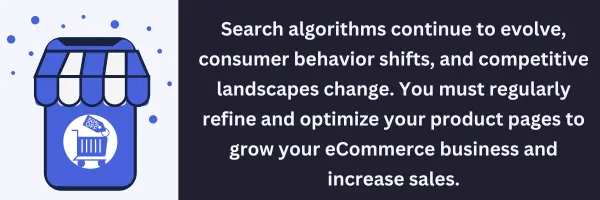
Ready to transform your online store’s organic performance and create content that resonates with your target audience?
Our agency specializes in implementing these exact SEO strategy approaches for retailers across multiple industries, consistently delivering revenue growth through improved organic visibility. Contact us today for a comprehensive audit of your eCommerce product web pages and a customized implementation roadmap.




